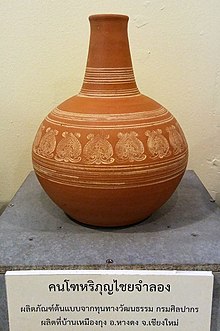Hariphunchai National Museum
The Hariphunchai National Museum ( Thai พิพิธภัณฑสถาน แห่ง ชาติ หริ ภุ ญ ไชย , RTGS Phiphithaphanthasathan Haeng Chat Hariphunchai ) is located in the city of Lamphun (historically Haripunjaya or Hariphunchai ), the capital of the Amphoe Mueang Lamphun (county) and the province of Lamphun , in northern Thailand . It is one of more than 40 Thai museums that have achieved the status of a national museum .
history
The Hariphunchai National Museum was founded in 1927 by Praya Rachanakulvibulbhakdi, the governor of the then Province ( Monthon ) Phayap (German: Northwest ), for which he initially used a pavilion on the grounds of Wat Phra That Hariphunchai . Supervision was later placed in the hands of the Fine Arts Department (Ministry of Culture). In 1974 the museum received its building, which is still in use today, a representative, two-storey and asymmetrical three-wing structure with an outdoor area and ancillary buildings.
The name of the museum refers to the historical empire Hariphunchai (8th / 9th to 13th century), whose capital of the same name was Lamphun at that time.
Permanent exhibitions
The permanent exhibitions of the National Museum focus on the area of Lamphun province or the former Hariphunchai and temporally the Mon culture (7th to 13th centuries) and the Lan Na period (14th to 19th centuries).
Hall with inscription stones
The hall on the ground floor contains a total of 26 inscription stones, eight of them from the Mon and 18 from the Lan Na period. The development from the Mon - via the Lanna - to the Thai script over several centuries can be traced here.
- Inscription stones of the Hariphunchai National Museum
Main exhibition hall
The exhibits in the elongated main exhibition hall on the upper floor are divided into two larger exhibition groups according to their time: the artifacts of the Hariphunchai group and the objects of the Lan-Na group. There is also a relatively small group with prehistoric exhibits right at the entrance.
Hariphunchai group (Mon time)
In this group, the influences of the Indian Pala - and that of the Indian-influenced southern Thai Dvaravati culture - on the art and handicrafts of the empire of Hariphunchai are presented. The influence of the latter manifests itself particularly in portrait art through typical Dvaravati features such as thick eyebrows connected to one another, sunken eyes with the corners of the eyes drawn up outwards, and lips that are hinted at open. This led archaeologists to interpret the art of Hariphunchai as belonging to the late Dvaravati culture.
This part of the exhibition also includes an extensive ceramics collection, of which the earthenware covered with slip and decorated with fine incisions is particularly striking. The exhibits of this type of ceramic are mainly urns and water containers.
Lan-Na group
The exhibition group of the Lan-Na period is divided into four subgroups:
- The first subgroup shows the emergence of Lan-Na art as an independent style from the roots of Khmer , Pala and Hariphunchai art.
- The second sub-group shows the full bloom and perfection of Lan-Na art with developed independence. The artists of this time were able to exchange ideas with their contemporaries from the kingdoms of Sukhothai and Ayutthaya and to integrate influences from there.
- The third subgroup includes local and regional styles and specializations. In addition to sculptures, porcelain from various pottery centers such as San Kamphaeng is a focus of the collection.
- The fourth subgroup finally comprises art from the late 18th century onwards, which was more and more shaped by the contemporary Rattanakosin style of Bangkok . The more the Siamese and later Thai capital gained political and economic influence in the north, the stronger the artistic impulses it emanated.
literature
- Michael Freeman: Lanna - Thailand's Northern Kingdom . River Books, Bangkok 2001, ISBN 0-500-97602-3 , p. 115
- Hariphunchai National Museum (Ed.): Hariphunchai National Museum . Six-page information leaflet, Lamphun o.J.
Web links
- Lamphun - Hariphunchai National Museum , Japanese website (English) with a description of the museum and extensive images, accessed on April 28, 2017
Individual evidence
- ↑ a b c Hariphunchai National Museum (ed.): Hariphunchai National Museum . Six-page information leaflet, Lamphun o.J.
- ↑ Poj Koekul: Kreung Too-ay Laa Tao Pao (Sankamphaeng Ceramics and Kilns). Department of Fine Arts, Bangkok 1972.
- ↑ Kraisri Nimmanahaeminda: Sankampaeng Glazed Pottery. Konmuang, Chiang Mai 1960.
Coordinates: 18 ° 34 ′ 38 " N , 99 ° 0 ′ 23.5" E









